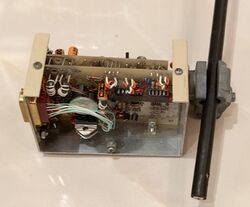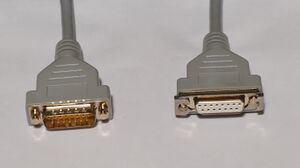Difference between revisions of "Ethernet transceiver"
m (Jnc moved page Ethernet Transceiver to Ethernet transceiver without leaving a redirect: second word not usually capitalized in generic term) |
m (+Experimental Ethernet transceiver image) |
||
| (4 intermediate revisions by 2 users not shown) | |||
| Line 1: | Line 1: | ||
| − | + | [[Image:ExperimentalEthernetTransceiver.jpg|250px|thumb|right|Experimental Ethernet transceiver attached to coaxial cable]] | |
| − | |||
| − | |||
| − | |||
| − | |||
| − | |||
| − | + | An '''Ethernet transceiver''' performs the [[analog]] functions necessary to connect one of the following [[Ethernet]] cable types: | |
| − | + | * [[Thickwire]] [[coaxial cable]] | |
| + | * [[Thinwire]] coaxial cable | ||
| + | * [[Twisted pair]] | ||
| + | * [[Fiber optic]] (different types) | ||
| + | |||
| + | to an [[network interface]]; the connection from the interface to the transceiver uses a transceiver cable. | ||
| + | |||
| + | Most modern standard Ethernet interfaces have the transceiver included in the network interface module (resp. interface chip), so that neither separate transceiver nor transceiver cable are needed. | ||
| + | |||
| + | Many recent high-speed Ethernet interfaces (1 GB/s and above) and [[Network switches|switches]] have transceivers again; that enables them to flexibly adapt to different network media, e.g. different types of fiber optical cables. | ||
<Picture of a recent Transceiver module> | <Picture of a recent Transceiver module> | ||
| Line 14: | Line 18: | ||
==Transceiver Cables== | ==Transceiver Cables== | ||
| − | [[File:AUI_DROP.jpg| | + | [[File:AUI_DROP.jpg|300px|thumb|left|Transceiver Cable, thin "Office Type"]] |
| + | |||
| + | The cable from the transceiver to the network interface is a standard in the [[DIX Ethernet]] specification; this allows transceivers, cables and network interfaces from multiple manufacturers to be interconnected. | ||
<br clear=all> | <br clear=all> | ||
| + | |||
| + | ==IEEE 802.3 Standard Naming Conventions== | ||
| + | |||
| + | The [[IEEE 802.3]] Ethernet Standard named: | ||
| + | |||
| + | * the Ethernet Transceiver '''MAU''' (for: '''Media Access Unit'''), and | ||
| + | * the Ethernet Transceiver Interface '''AUI''' (for: '''Attachment Unit Interface'''). | ||
| + | |||
| + | The Transceiver cable was thus named '''AUI cable'''. | ||
==Ethernet Transceiver Functions== | ==Ethernet Transceiver Functions== | ||
| Line 31: | Line 46: | ||
* Maintains low loading/high impedance on the coaxial cable, | * Maintains low loading/high impedance on the coaxial cable, | ||
* Provides continuous data loopback (i.e., the receiver portion of the transceiver is always active; thus, the message being transmitted is coupled back on the transceiver cable), | * Provides continuous data loopback (i.e., the receiver portion of the transceiver is always active; thus, the message being transmitted is coupled back on the transceiver cable), | ||
| − | * Provides self test of the collision detection circuitry at the end of each transmission, | + | * Provides self-test of the collision detection circuitry at the end of each transmission, |
* Contains protective circuitry which ensures that network integrity will be maintained in the event of a faulty transceiver, controller, or repeater. | * Contains protective circuitry which ensures that network integrity will be maintained in the event of a faulty transceiver, controller, or repeater. | ||
| + | |||
| + | ==See also== | ||
| + | |||
| + | * [[DEC Ethernet Transceivers]] | ||
| + | |||
| + | ==External links== | ||
| + | |||
| + | * [https://www.computerhistory.org/collections/catalog/X124.82E Experimental Ethernet transceiver] - at the [[Computer History Museum|CHM]]; includes a clamped-on vampire tap housing | ||
| + | * [http://www.bitsavers.org/pdf/xerox/alto/ethernet/Ethernet_Transceiver_Electrical_Characteristics.pdf Ethernet Transceiver Electrical Characteristics] - complete Experimental Ethernet transceiver specification, including engineering drawings | ||
| + | |||
| + | [[Category: Networking]] | ||
Latest revision as of 14:55, 17 November 2024
An Ethernet transceiver performs the analog functions necessary to connect one of the following Ethernet cable types:
- Thickwire coaxial cable
- Thinwire coaxial cable
- Twisted pair
- Fiber optic (different types)
to an network interface; the connection from the interface to the transceiver uses a transceiver cable.
Most modern standard Ethernet interfaces have the transceiver included in the network interface module (resp. interface chip), so that neither separate transceiver nor transceiver cable are needed.
Many recent high-speed Ethernet interfaces (1 GB/s and above) and switches have transceivers again; that enables them to flexibly adapt to different network media, e.g. different types of fiber optical cables.
<Picture of a recent Transceiver module>
Contents
Transceiver Cables
The cable from the transceiver to the network interface is a standard in the DIX Ethernet specification; this allows transceivers, cables and network interfaces from multiple manufacturers to be interconnected.
IEEE 802.3 Standard Naming Conventions
The IEEE 802.3 Ethernet Standard named:
- the Ethernet Transceiver MAU (for: Media Access Unit), and
- the Ethernet Transceiver Interface AUI (for: Attachment Unit Interface).
The Transceiver cable was thus named AUI cable.
Ethernet Transceiver Functions
From "EK-H4000-TM-PRE H4000 Ethernet Transceiver Technical Manual", chapter 1.2.2 "Transceiver Functional Description":
The transceiver performs the following functions:
- Transmit: Responds to the signals input from the transceiver cable and transmits the signals on the coaxial cable.
- Receive: Responds to signals transmitted on the coaxial cable and couples the received signals to the transceiver cable.
- Collision Detect: Monitors the signals transmitted on the coaxial cable and, if a collision occurs, signals appropriately on the transceiver cable.
Additionally, the transceiver does the following:
- Maintains electrical isolation between the coaxial cable and the transceiver cable,
- Maintains low loading/high impedance on the coaxial cable,
- Provides continuous data loopback (i.e., the receiver portion of the transceiver is always active; thus, the message being transmitted is coupled back on the transceiver cable),
- Provides self-test of the collision detection circuitry at the end of each transmission,
- Contains protective circuitry which ensures that network integrity will be maintained in the event of a faulty transceiver, controller, or repeater.
See also
External links
- Experimental Ethernet transceiver - at the CHM; includes a clamped-on vampire tap housing
- Ethernet Transceiver Electrical Characteristics - complete Experimental Ethernet transceiver specification, including engineering drawings

